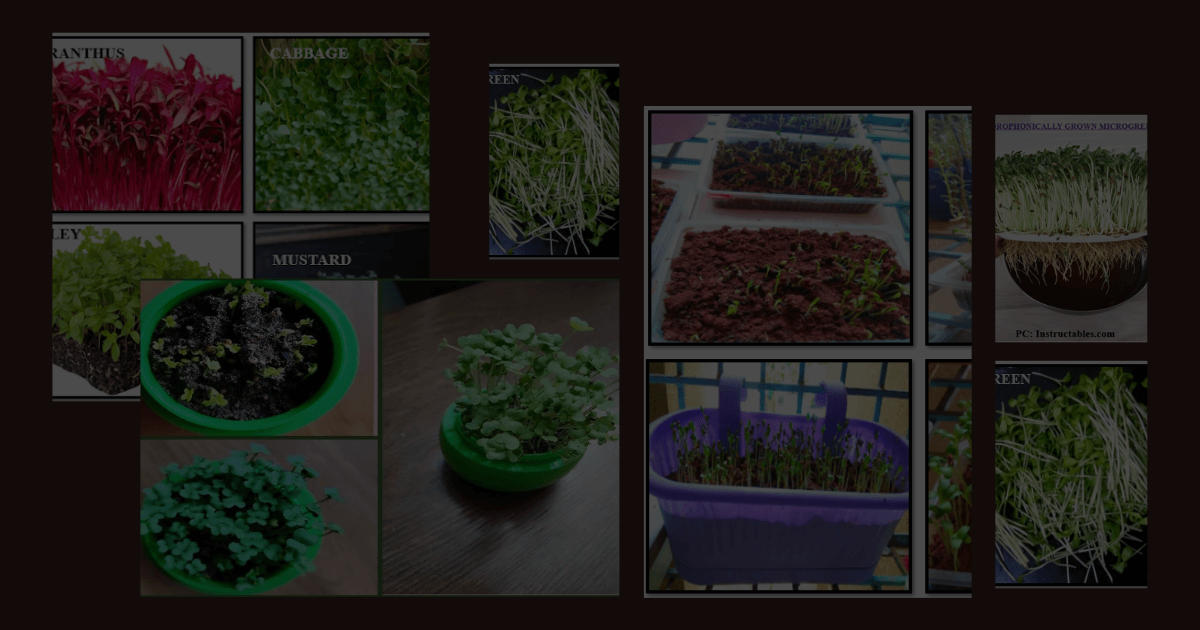Few must know amazing facts…………….
The pandemic has made an eminent impact on all of us to a great extent either in the way we think about our health or in our attitudes towards staying fit. There has also been a considerable rise in the consumption of plant products and an inclination towards organic foods with the emergence of the concept of conscious diet among people. People are increasingly becoming more health conscious and at the same time are more concerned about their environment in an attempt to boost their immunity. Hence, it is definitely the right time to introduce the most impressive and evolving crop of the modern times: The Microgreens!!!!!
Even though the “microgreens” are popular foods in western countries and are recognized as functional foods or superfoods, in India many people are still unfamiliar with the concept of “microgreens”. Therefore, this article has been penned down mainly to create an awareness among people about this appealing crop, focus on the must know facts about microgreens and to answer all the frequently asked questions about them.
Microgreens are best suited for people staying in cities or those with limited spaces. They can be grown without the need for a lot of space like indoors/ balconies/ utility spaces/ corner of a room/ basements etc.
1. What are microgreens?
Answer: Microgreens are the young and tender edible seedlings harvested when the cotyledon leaves or the embryonic leaves have fully developed, and the first true leaves appear.
2. How do the microgreens differ from that of sprouts?
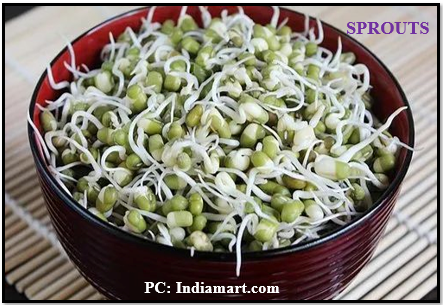
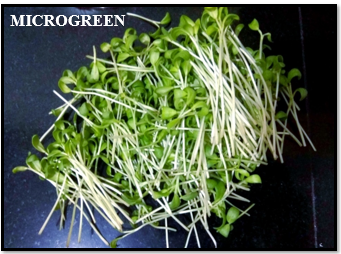
Answer: Microgreens are not the same as that of sprouts. Sprouts are the newly germinated seedlings that are usually grown in water and are harvested within 2-3 days before the cotyledon leaves begin to grow. On the contrary, microgreens grow from the sprouts. If the sprouts are grown for a few more days or weeks (depending upon the variety), in soil or any other growing media in the presence of sunlight, then the cotyledon leaves develop and it becomes a microgreen.
Microgreens are harvested above the soil line while leaving behind seeds and roots when the plants are approximately 2 inches tall. The stem, cotyledons (or seed leaves) and first set of true leaves are all edible.
3. What are the benefits of microgreens over sprouts?
Answer:
- Microgreens are safer to consume than sprouts: Microgreens are grown in an environment with more sunlight and ventilation and therefore, less chances of bacterial infestation. They are harvested above the soil line leaving behind roots and seeds. Food safety is not an issue with microgreens as compared to that of sprouts which are eaten entirely.
- Wide variety of microgreens are available: Over 80 types of microgreens can be grown. Therefore, more colors and textures are possible with microgreens whereas sprouts are limited in choices.
- Nutritional and fiber content are more in microgreens
- Microgreens have higher concentration of antioxidants
- Microgreens can be stored for a longer time in the refrigerator as compared to that of sprouts.
4. Why are microgreens called “superfoods?”
Answer: The term “superfoods” refers to foods that provide maximum nutritional benefits for minimal calories. Microgreens are nutritionally rich foods that may deliver higher health benefits when added in our everyday nutrition. This is supported by evidence that the microgreens provide higher concentrations of nutrients than their mature counterparts. They are a good source of vitamins, minerals, and antioxidants. Hence, they can be considered as superfoods.
For example: According to a study by the USDA National Nutrient database for Standard Reference, red cabbage microgreens had six times more Vitamin C than the mature red cabbage itself. In addition, the red cabbage microgreens had 40 times the Vitamin E than its mature counterpart.
5. What can be grown as microgreens?
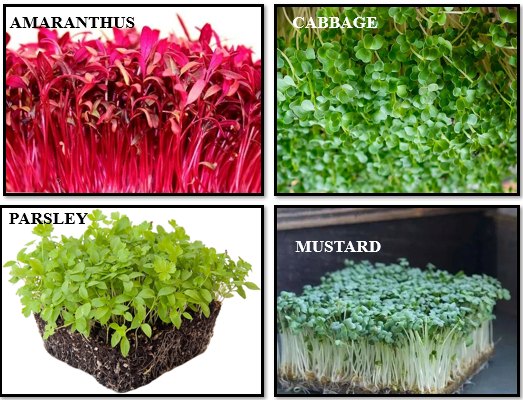
Answer: No special seeds are required for growing microgreens. However, some seeds are better suited and more preferred than the others. Any herb or vegetable (leafy vegetables/ salad greens) can be chosen for growing microgreens. The commonly preferred ones include: Amaranth, Basil, Kale, Broccoli, Mustard, Beet, Parsley, Pea, Turnips, Radish, Spinach, Lettuce, Cabbage etc.
Microgreens are 4-40 times richer in nutrients as compared to their mature counterparts.
6. What are the health benefits of microgreens?
Answer: Microgreens offer several health benefits as they are rich in nutrients (vitamins, minerals, fiber and antioxidants). They contain 4-40 times more nutrients than their mature counterparts. They have a wider variety of polyphenols and an elevated level of Vitamins like E, K, C, lutein and beta carotenes.
- Vitamin E acts as an antioxidant, cardioprotective and is also good for skin.
- Vitamin C helps to boost our immunity and stimulates the iron absorption in the gut.
- Beta carotenes help in cell growth and bone development and are also good for the immune system.
- Polyphenols prevent the accumulation of free radicals in the body and are associated with reduced risk of heart diseases, cancer and Alzheimer’s disease.
Microgreens also prevent the risk of chronic diseases like chronicinflammatory disorders, diabetes and obesity. They help to regulate the body weight, maintain the blood glucose levels and aid in tissue repair. They help in detoxification of the body.
7. Are microgreens really feasible to be grown?
Answer: Microgreens are definitely feasible to grow due to various reasons:
- Microgreens are best suited for people staying in cities or those with limited spaces. They can be grown without the need for a lot of space like indoors/ balconies/ utility spaces/ corner of a room/ basements etc. They require moderate amounts of sunlight and thus can be kept outdoors where it is not too sunny. While growing indoors, they can be placed near a bright window or under a table lamp using LED/ fluorescent bulbs.
- Microgreens are 4-40 times richer in nutrients as compared to their mature counterparts. They are power packs of energy and can be grown using 25 times less resources as compared to the mature greens for the same nutritional content.
- They can be grown using only water (hydrophonically) and do not require soil too.
- They do not require to be watered or manured frequently as their mature counterparts.
- They take just a few days to weeks to grow. So, it is possible to have a continuous supply of nutrient rich food every week if you grow various microgreens on rotation.
- It is not expensive to grow microgreens. Any eco-friendly and food safe containers can be used for growing the microgreens like the biodegradable plastic parcel boxes, ceramic casserole dishes, cardboard boxes used for packaging, trays, bowls, glass jars, coconut shells, egg/ milk cartons, saucers, aluminum tins, coffee mugs etc.
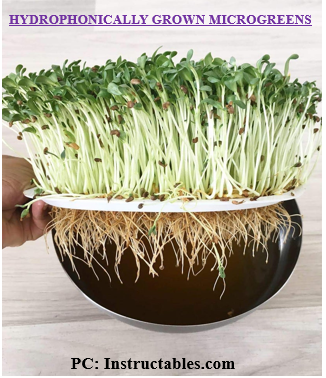
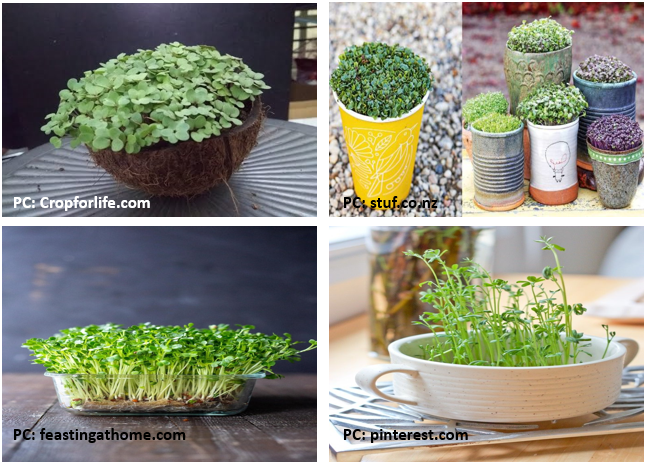
Their fine and gross motor skills will improve too while they get indulged themselves in various steps of growing microgreens.
8. Will the microgreens regrow after cutting?
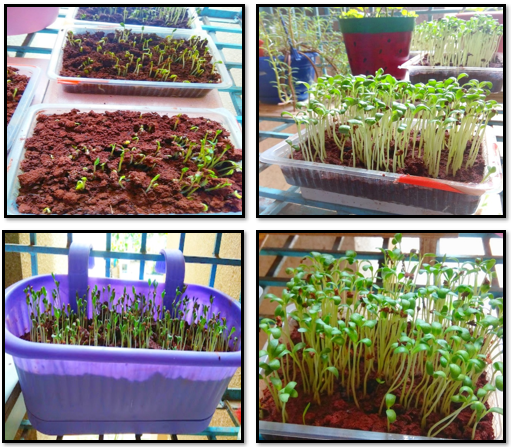
Answer: No, the microgreens do not grow after cutting because all the nutrition is utilized in producing the first cotyledon leaves and so no energy will be left out for the microgreens to grow again after cutting.
9. What are the benefits of growing microgreens at home for your kids?
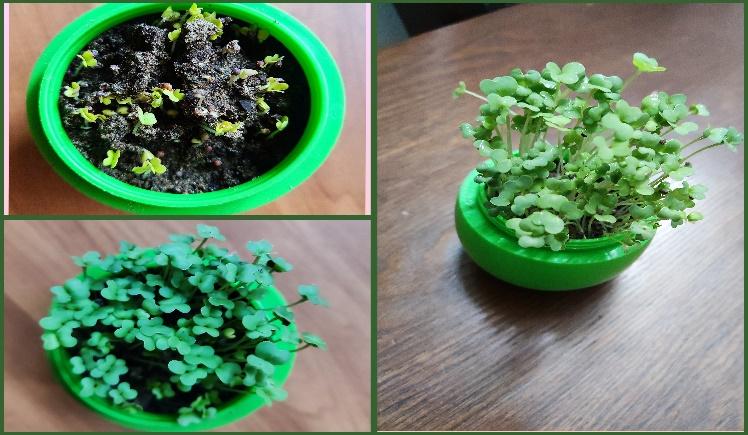
Answer:
- Growing microgreens is the simplest, impressive and creative way to get your kids involved in gardening activities away from the world of electronic gadgets. It helps them to build and express their imaginative powers and they will be fascinated by the whole process of how a tiny seed turns into a beautiful plant!
- Growing microgreens at home can be an easy, fun-filled and exciting activity for kids. They will be introduced to the new terms like sprouts, microgreens, sowing, germination, watering, harvesting etc.
- Above all, they will learn the values of caring for a life and at the same time explore and closely observe the steps of a plant’s growth.
- Their fine and gross motor skills will improve too while they get indulged themselves in various steps of growing microgreens.
- They will be interested in consuming the microgreens grown by themselves and which will add a variety of extraordinary flavors, brilliant colors and exquisite textures to the salads, sandwiches, garnishes, seasonings, omelets, pastas, pizzas etc.
Composed by: “Dr. Shubha.H.V is a Consultant Pathologist/Lab Head, SRL Diagnostics, Fortis Hospital, Rajajinagar, Bangalore. “

